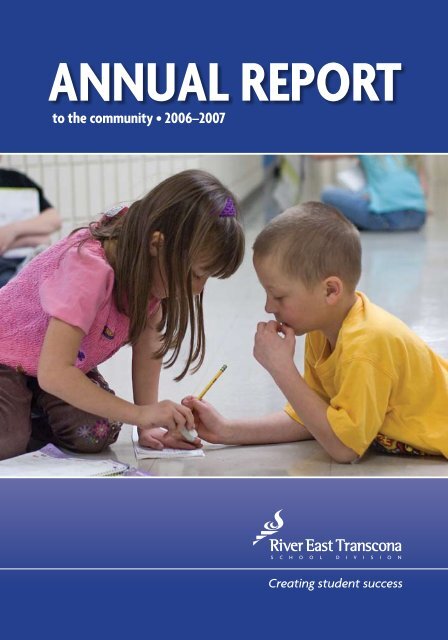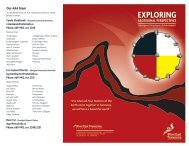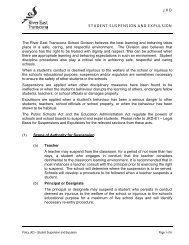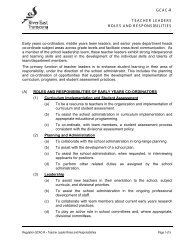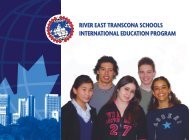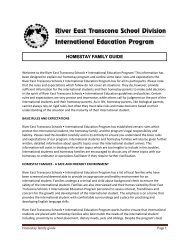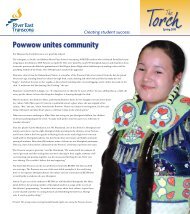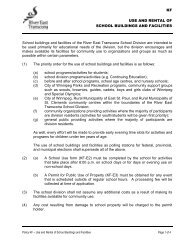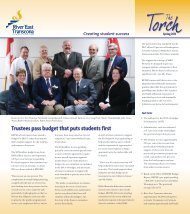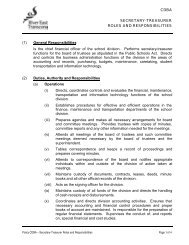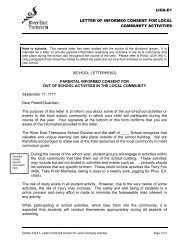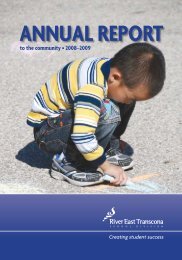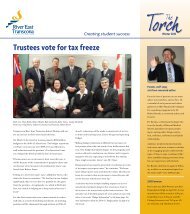student success - River East Transcona School Division
student success - River East Transcona School Division
student success - River East Transcona School Division
Create successful ePaper yourself
Turn your PDF publications into a flip-book with our unique Google optimized e-Paper software.
ANNUAL REPORT<br />
to the community • 2006–2007<br />
Creating <strong>student</strong> <strong>success</strong>
PURPOSE<br />
The <strong>River</strong> <strong>East</strong><br />
<strong>Transcona</strong> <strong>School</strong><br />
<strong>Division</strong> exists to<br />
educate <strong>student</strong>s<br />
to be inspired,<br />
skilled, responsible<br />
citizens.<br />
VISION<br />
The <strong>River</strong> <strong>East</strong><br />
<strong>Transcona</strong> <strong>School</strong><br />
<strong>Division</strong> will be<br />
forward-looking,<br />
innovative and<br />
service-oriented,<br />
offering superior,<br />
comprehensive<br />
programming<br />
to meet the<br />
emerging needs<br />
of our <strong>student</strong>s<br />
and community.<br />
MISSION<br />
To fulfill our purpose<br />
and in our<br />
journey toward our<br />
vision, the <strong>River</strong><br />
<strong>East</strong> <strong>Transcona</strong><br />
<strong>School</strong> <strong>Division</strong><br />
is committed to<br />
provide:<br />
Relevant, progressive<br />
educational<br />
programming and<br />
supportive services<br />
in a safe, stimulating<br />
learning environment.<br />
greetings<br />
It is a great pleasure to present you with just some of the<br />
new and ongoing initiatives that are a source of pride<br />
for us in <strong>River</strong> <strong>East</strong> <strong>Transcona</strong> <strong>School</strong> <strong>Division</strong>.<br />
It is a challenge to portray the scope of evolution that<br />
occurs in our division every year. We have highlighted a<br />
few of the topics that demonstrate how we are working<br />
toward objectives that are ever-present: improving<br />
<strong>student</strong> <strong>success</strong>, enhancing teacher and <strong>student</strong> technology skills, building connections<br />
with our community, and ensuring the safety of all staff and <strong>student</strong>s.<br />
This has been another banner year for <strong>River</strong> <strong>East</strong> <strong>Transcona</strong> <strong>School</strong> <strong>Division</strong><br />
and this report gives you a good sense of the hard work being done by all of our<br />
<strong>student</strong>s and staff. We hope you enjoy reading it.<br />
Dennis Pottage<br />
Superintendent/CEO<br />
<strong>River</strong> <strong>East</strong> <strong>Transcona</strong> <strong>School</strong> <strong>Division</strong><br />
On behalf of the <strong>River</strong> <strong>East</strong> <strong>Transcona</strong> <strong>School</strong> <strong>Division</strong><br />
board of trustees, I am pleased to present our third<br />
annual report to the community. We hope you will find<br />
the information within to be interesting and enlightening.<br />
The face of education is constantly changing to meet<br />
the needs of <strong>student</strong>s. This report touches on just a few<br />
examples of the directions our division is taking to cultivate both the hearts and<br />
minds of the children who represent our future. By highlighting these initiatives,<br />
we hope you will feel informed about the progress our division is making in working<br />
“Toward improved <strong>student</strong> learning and the development of inspired, skilled,<br />
responsible citizens,” one of our strategic directions.<br />
Robert Fraser<br />
Chair, Board of Trustees 2006-07<br />
<strong>River</strong> <strong>East</strong> <strong>Transcona</strong> <strong>School</strong> <strong>Division</strong><br />
divisional priorities 2007-08<br />
1. Strengthen assessment practices to inform teaching and enhance learning.<br />
2. Create and enhance safe and respectful school cultures.<br />
3. Support teaching and learning by extending purposeful use of<br />
technology.<br />
4. Enrich educational opportunities for <strong>student</strong>s through purposeful connections<br />
between the division and its community.
FinanCial details<br />
<strong>River</strong> <strong>East</strong> <strong>Transcona</strong> <strong>School</strong> <strong>Division</strong> is responsible for providing adequate<br />
resources and skilled professional and support staff to educate, guide and serve<br />
the needs of our <strong>student</strong>s so they can learn and progress to the fullest extent<br />
possible.<br />
The following breakdown of budget expenditures provides a detailed look into<br />
how money is distributed to key areas. It illustrates that the focus of our budget<br />
continues to be on preserving essential programming and providing resources<br />
to instructional activities.<br />
In this budget, support activities such as operations and maintenance, division<br />
administration, transportation and payroll tax, represented 20 per cent of the<br />
operating expenditures. This means 80 per cent of the budget was directed to<br />
<strong>student</strong>s.<br />
RETSD 2006-07 Budget<br />
Instructional Programs DOLLARS %<br />
Regular Instruction 84,302,735 59.6<br />
Exceptional 22,556,240 15.9<br />
Instruction & Pupil Support Services 6,342,443 4.5<br />
Total budget for instruction programs 113,201,418 80.0<br />
Support Services DOLLARS %<br />
<strong>Division</strong> Administration 4,227,338 3.0<br />
Community Education & Services 581,195 0.4<br />
Transportation of Pupils 2,604,300 1.8<br />
Operations & Maintenance 17,135,100 12.1<br />
Payroll Tax & Interest 2,357,000 1.7<br />
Capital Expenditures 1,412,700 1.0<br />
Total budget for support services 28,317,633 20.0<br />
Grand total • all areas 141,519,051 100<br />
BUDGET FACTS<br />
The following is a summary<br />
of income sources for the<br />
2006-07 school year:<br />
Provincial program funding<br />
55.2%<br />
Local special levy<br />
33.7%<br />
Education property tax credit<br />
8.7%<br />
Other provincial sources<br />
1.7%<br />
Non-provincial sources<br />
0.7%<br />
The following is a summary<br />
of expenditures for the<br />
2006-07 school year:<br />
Salaries and benefits<br />
82.6%<br />
Services and utilities<br />
9.3%<br />
Supplies, materials and equip-<br />
ment<br />
5.3%<br />
Interest, payroll tax and<br />
<strong>School</strong>s of Choice<br />
1.8%<br />
Capital expenditures<br />
1.0%
2<br />
STUDENT SUCCESS<br />
developing math skills<br />
Inspired by the <strong>success</strong> of an initiative at Salisbury Morse Place <strong>School</strong>, <strong>River</strong> <strong>East</strong> <strong>Transcona</strong> <strong>School</strong><br />
<strong>Division</strong> is now developing a program designed to help <strong>student</strong>s become better mathematicians.<br />
In 2006-07, a two-year pilot of the Early Numeracy Intervention Project (ENIP) was launched in eight<br />
schools in the division. Designed by a team of educators from the division and based on the work of<br />
Wright, Martland and Stafford, the project supports kindergarten and Grade 1 <strong>student</strong>s in developing<br />
early number sense. Seven individuals have been specially-trained to become the project’s facilitators.<br />
For the first five months of the pilot, the facilitators worked on early numeracy with all kindergarten<br />
<strong>student</strong>s. For the remainder of the school year, facilitators worked with those kindergarten <strong>student</strong>s<br />
identified as benefiting from additional support. A number of Grade 1 <strong>student</strong>s also received additional<br />
support through the project.<br />
Facilitators worked with the <strong>student</strong>s on a one-on-one basis, in pairs, or in groups of three in regularly<br />
scheduled 10 to 15-minute sessions. During the sessions, children strengthened their understanding<br />
of the “big ideas” associated with early number sense—for example, counting, recognizing numbers,<br />
understanding that numbers represent quantities and recognizing that there are relationships between<br />
numbers (such as one-more-than, one-less-than, making fives and tens, doubles and near doubles). Understanding<br />
these ideas helps children build strategies that lead to later <strong>success</strong> in mathematics.<br />
The ENIP was monitored closely during its first year and assessment of both the project and <strong>student</strong><br />
learning was ongoing. Initial results show significant growth in the number sense of <strong>student</strong>s involved in<br />
the project at each of the eight schools.<br />
In 2007-08, the project’s structure will be further refined, with emphasis on intensifying the link<br />
between the classroom and the work of the facilitator, and adjusting the assessment tools used in the<br />
project. The long range plan is to gradually introduce the Early Numeracy Intervention Project into all<br />
early years schools in the division.
inCreasing literaCy<br />
Grade 1 children in <strong>River</strong> <strong>East</strong> <strong>Transcona</strong> <strong>School</strong> <strong>Division</strong> who are having<br />
difficulty learning how to read and write are getting the extra help they need<br />
through Reading Recovery, a program that yields impressive results.<br />
In 2006-07, a total of 173 Grade 1 <strong>student</strong>s received extra help with reading<br />
and writing through Reading Recovery. As a result of the program, about 75<br />
per cent of those children brought their reading level up to the average in the<br />
classroom, a percentage that exceeds the international <strong>success</strong> level.<br />
The results have a lasting impact, too. The division tracks the performance of<br />
former Reading Recovery <strong>student</strong>s through to Grade 6 and statistics show the<br />
majority maintain the average reading level for their classroom. Reading Recovery<br />
gives <strong>student</strong>s the strategies they need for continued academic <strong>success</strong>.<br />
Reading Recovery was founded in 1978 by Dame Marie Clay, a professor at the<br />
University of Auckland, New Zealand. The program has since attained international<br />
recognition as a <strong>success</strong>ful intervention strategy for young readers. It has<br />
been used in <strong>River</strong> <strong>East</strong> and <strong>Transcona</strong> schools for about a decade. The division<br />
currently has 26 Reading Recovery teachers.<br />
Reading Recovery involves daily 30-minute individual lessons, conducted outside<br />
of the classroom, for 12 to 20 weeks. The lessons, tailored to each <strong>student</strong>’s<br />
unique needs, focus on comprehension in reading and constructing messages<br />
in writing. Students spend time with the Reading Recovery teacher reading<br />
books, writing stories and drawing from their own experience and knowledge to<br />
develop strategies that will help them become better readers and writers.<br />
FAST FACTS<br />
RETSD READING<br />
RECOVERY STATISTICS<br />
Total number of Grade 1<br />
<strong>student</strong>s • 888<br />
Number of Grade 1 <strong>student</strong>s<br />
participating in Reading<br />
Recovery • 173<br />
Participation by gender •<br />
102 boys, 71 girls<br />
Long-term results<br />
The long-term achievement<br />
of former Reading Recovery<br />
<strong>student</strong>s is tracked to Grade<br />
5 in the areas of reading and<br />
writing. The following results<br />
are for <strong>student</strong>s who, over<br />
time, have performed in the<br />
average range or above:<br />
Grades 2–3<br />
Reading 85%<br />
Grades 2–3<br />
Writing 83%<br />
Grades 4–6<br />
Reading/writing 72%<br />
EARLY NUMERACY<br />
INTERVENTION PROJECT<br />
SCHOOLS<br />
Emerson Elementary <strong>School</strong><br />
Joseph Teres <strong>School</strong><br />
Maple Leaf <strong>School</strong><br />
Polson <strong>School</strong><br />
Prince Edward <strong>School</strong><br />
Princess Margaret <strong>School</strong><br />
Radisson <strong>School</strong><br />
Salisbury Morse Place <strong>School</strong><br />
Wayoata Elementary <strong>School</strong>
strength in numbers<br />
Each year, <strong>River</strong> <strong>East</strong> <strong>Transcona</strong> <strong>School</strong> <strong>Division</strong> participates in a province-wide assessment of <strong>student</strong><br />
learning. Provincial assessments are completed in three areas:<br />
• Grade 3 classroom-based assessment of reading and numeracy, and Grade 4 assessment of French Immersion<br />
lecture<br />
• Middle years classroom-based assessment of key competencies in mathematics, reading comprehension<br />
and expository writing<br />
• Grade 12 curriculum-based standards test in language arts and mathematics.<br />
The newest of these provincial assessments, the Grade 7 and 8 middle years assessment, was introduced<br />
in January 2007. For additional information about the provincial assessment program, contact your<br />
child’s teacher.<br />
Grade 3 division results • 2006<br />
Mathematics<br />
ME NSH NOH<br />
Eng. % F I % Eng. % F I % Eng. % F I %<br />
Sorts objects 73.1 73.3 22.7 15.9 4.3 10.2<br />
Measurement 67.5 77.8 28.2 19.3 4.3 2.8<br />
Addition facts 49.4 61.9 31.5 29.5 19.1 8.5<br />
Subtraction facts 26.2 30.7 36.0 40.3 37.8 29.0<br />
Extends and describes patterns 55.9 77.8 35.7 19.9 8.4 1.7<br />
Problem-solving 50.3 54.0 38.2 34.7 11.5 11.9<br />
Compares numbers 70.5 77.3 21.2 19.3 8.4 3.4<br />
Place Value 64.4 71.6 24.4 25.0 11.3 3.4<br />
Graphing 76.0 73.9 21.3 21.0 2.7 5.1<br />
Reading<br />
Reflection 72.1 80.8 21.4 15.8 6.5 3.4<br />
Oral reading 71.3 79.7 15.3 13.0 13.5 7.3<br />
Comprehension 68.0 79.1 22.9 14.1 9.1 6.8<br />
Grade Lecture • Reading in French<br />
Reflection n/a 51.8 n/a 39.5 n/a 9.3<br />
Oral reading n/a 52.3 n/a 31.4 n/a 16.3<br />
Comprehension n/a 62.8 n/a 27.9 n/a 9.3<br />
ME • meets expectations NSH • needs some help NOH • needs ongoing help FI • French Immersion
Middle years provincial assessment results • 2006<br />
Grade 7 number sense and number skills<br />
Grade 12 provincial standards test results<br />
January 2006 June 2006 January 2007 June 2007<br />
DA% PA% DA% PA% DA% PA% DA% PA%<br />
English language arts 67.2 66.9 58.5 63.9 63.4 63.7 60.9 64.2<br />
French language arts 70.9 65.7 65.5 68.1 62.3 66.5 not available<br />
Mathematics • applied 46.1 54.3 57.8 61.7 63.8 64.8 58.2 64.2<br />
Mathematics • consumer 64.1 65.0 63.6 62.9 59.8 63.0 62.3 62.1<br />
Mathematics • pre-calculus 55.9 63.2 62.3 67.3 53.7 62.3 66.6 67.9<br />
DA • average division mark PA • average provincial mark<br />
ME APP NM OR<br />
Eng. % F I % Eng. % F I % Eng. % F I % Eng. % F I %<br />
Orders fractions 55.8 61.9 29.9 32.0 11.8 6.1 2.6 0<br />
Orders decimal numbers 66.7 78.2 24.5 15.2 6.1 6.6 2.6 0<br />
Number representation 57.1 68.0 29.9 28.4 10.4 3.6 2.6 0<br />
Uses number patterns 41.7 31.5 42.7 57.9 13.1 10.7 2.5 0<br />
Uses a variety of strategies 48.1 56.9 35.5 41.5 13.8 2.0 2.7 0<br />
Grade 8 expository writing<br />
Generates, selects & organizes ideas 54.5 77.4 13.6 19.5 8.8 3.2 5.0 0<br />
Chooses language to make impact 43.5 74.7 41.5 17.4 10.1 7.9 4.9 0<br />
Uses conventions & resources 49.2 71.6 34.4 24.7 11.5 3.7 4.8 0<br />
Grade 8 compréhension en lecture<br />
Understands key ideas & messages n/a 62.2 n/a 35.6 n/a 2.1 n/a 0<br />
Interprets a variety of texts n/a 63.3 n/a 33.5 n/a 3.2 n/a 0<br />
Responds critically to texts n/a 53.2 n/a 41.5 n/a 5.3 n/a 0<br />
ME • meeting mid-Grade 7 level performance APP • approaching mid-Grade 7 level performance<br />
NM • not meeting mid-Grade 7 level performance OR • out of range
6<br />
appropriate eduCation<br />
<strong>River</strong> <strong>East</strong> <strong>Transcona</strong> <strong>School</strong> <strong>Division</strong> (RETSD) is committed to maximizing the potential for all <strong>student</strong>s<br />
to participate in the academic and social life of their school and community.<br />
Through the supports provided by its Student Services Unit and Child Guidance Clinic—comprised<br />
of consultants, teachers, clinicians and other specialists—the division is well on its way to making this<br />
vision a reality. To enhance what is already in place, the unit launched a three-year plan in 2006-07 to<br />
develop and implement a service delivery model that further supports the creation of an inclusive culture<br />
in RETSD. The driving force comes from the 2004 RETSD Student Services Review and the Appropriate<br />
Educational Programming legislation (Bill 13) that came into effect in the province in 2005.<br />
The Student Services Unit has identified the supports and services already in place for <strong>student</strong>s and their<br />
families and created the Continuum of Supports, showing the extent of assistance available—beginning in<br />
the classroom and extending to the division and community.<br />
An audit of division policies and practices is being conducted to ensure they support the Appropriate<br />
Educational Programming legislation. As well, in early 2007, a long-term plan to promote physical accessibility<br />
for <strong>student</strong>s and their families was developed, and a community forum was held to strengthen<br />
partnerships with community agencies that work closely with Student Services Unit staff.<br />
Meanwhile, a review has begun of the specialized software and technology options available to enrich<br />
learning for children with special needs, and the process for individual educational planning was examined<br />
with an aim to advance the process.<br />
Guidelines soon will be developed to enhance the transition of <strong>student</strong>s between schools, as well as<br />
between their school and the community. The division has supported the training of a multi-disciplinary<br />
team to provide professional development and support for <strong>student</strong>s with Autism Spectrum Disorder.
superior skills<br />
Due to lower birth rates and an aging population, a skills shortage is on the<br />
rise, resulting in a high demand for trades people. By 2020, it is estimated<br />
Canada will be short one million workers. 1 In the manufacturing sector<br />
alone, 400,000 workers will be required in the next 15 years due to retirement.<br />
2 By 2007, more than one-third of jobs created in Canada will require<br />
trade certification or a college diploma. 3<br />
Skyrocketing demand and above-average earning potential combine to make<br />
trades a more than viable option for some <strong>River</strong> <strong>East</strong> <strong>Transcona</strong> <strong>student</strong>s.<br />
To meet this demand, the division offers opportunities for training in everything<br />
from advertising art and aerospace to welding and woodworking.<br />
The Skills Canada competition showcases the talent of many secondary and<br />
post-secondary <strong>student</strong>s enrolled in vocational education programs. The<br />
<strong>student</strong>s first compete on a provincial level, with gold medal winners moving<br />
on to the national competition. In 2007, the following <strong>River</strong> <strong>East</strong> <strong>Transcona</strong><br />
<strong>School</strong> <strong>Division</strong> <strong>student</strong>s gleaned nine gold medals at the Skills Manitoba<br />
competition and, of those gold medal winners, two received silver (S) and<br />
three received bronze (B) at the nationals in Saskatchewan.<br />
1 Conference Board of Canada, Canadian Outlook: Long-Term Forecast, 2000<br />
2 Canadian Manufacturers and Exporters, Ensuring the Future of Canadian Manufacturing, February 2005<br />
3 Job Futures 2000, www.jobfutures.ca<br />
skills manitoba gold medalists<br />
Kildonan <strong>East</strong> Collegiate<br />
Anthony Majure • 2-D Characteracter Computer Animation (S)<br />
Jonnathan Smadello • 2-D Characteracter Computer Animation (S)<br />
Tyler Filz • Baking<br />
Nick Kruse • Culinary Arts<br />
Nicole Neufeld • IT Software Applications<br />
Miles Macdonell Collegiate<br />
Joel Lamb • IT and Network Support (B)<br />
Rychee Sam • Aesthetics (Nail Technician)<br />
Murdoch Mackay Collegiate<br />
Kyle Kolke • Precision Machining (B)<br />
Samantha Wichenko • Women’s Apparel Design (B)<br />
FAST FACTS<br />
SKILLS MANITOBA<br />
SILVER MEDALISTS<br />
Kildonan <strong>East</strong> Collegiate<br />
Jason Anderlic • 3-D Character<br />
Computer Animation<br />
Joshua Jacobson • 3-D Charac-<br />
ter Computer Animation<br />
Scott White •<br />
Website Development<br />
Miles Macdonell Collegiate<br />
Scott Lao • Photography<br />
Manpreet Saini • Aesthetics<br />
Nick Luchak • 2-D Character<br />
Computer Animation<br />
Corey Doncette • 2-D Charac-<br />
ter Computer Animation<br />
Murdoch MacKay Collegiate<br />
Sabrina Fehr •<br />
Women’s Apparel Design<br />
Tyler Chubb •<br />
Precision Machining<br />
Matthew Sanscartier •<br />
Prepared speech<br />
SKILLS MANITOBA<br />
BRONZE MEDALISTS<br />
Kildonan <strong>East</strong> Collegiate<br />
Kurt Neumann •<br />
Electrical Wiring<br />
Miles Macdonell Collegiate<br />
Kayla Warman • Aesthetics<br />
Murdoch MacKay Collegiate<br />
Keeley Braunstein-Black •<br />
Women’s Apparel Design<br />
<strong>River</strong> <strong>East</strong> Collegiate<br />
Spencer Loewen • 3-D Charac-<br />
ter Computer Animation<br />
Blair Thiessen • 3-D Character<br />
Computer Animation
8<br />
CARING SCHOOLS<br />
maximizing <strong>student</strong> potential<br />
<strong>River</strong> <strong>East</strong> <strong>Transcona</strong>’s spirit of innovation continues to grow, with the division’s programming being<br />
continuously fine-tuned to meet the needs of individual <strong>student</strong>s.<br />
In 2006, staff from Munroe Junior High <strong>School</strong> unveiled a new divisional project they spearheaded in<br />
collaboration with the superintendent’s department and board of trustees.<br />
All Students Achieving Potential (ASAP) involves the collaboration of classroom and resource teachers<br />
with educational interns and teaching partners to deliver instruction that maximizes the potential for<br />
addressing the needs of all <strong>student</strong>s, ranging from at-risk to gifted. A social worker and school counsellor<br />
provide whole-class social skills training and enhanced partnerships with families. The school counsellor<br />
plays a central role in implementing Munroe’s “restorative discipline” model through mediation and<br />
conflict resolution. Paraprofessionals, parents and guardians are also part of the team.<br />
The ASAP model adapts the curriculum and environment in response to the learning diversity, interests<br />
and strengths of <strong>student</strong>s and is delivered to individuals or in flexible groupings. Students are integrated<br />
in the differentiated classroom, and are supported by the teams of classroom teachers, educational interns<br />
or teaching partners. Labels are avoided and all <strong>student</strong>s are seen as having unique gifts and talents.<br />
Such differentiated teaching also recognizes the development of appropriate social skills as a measure of<br />
improved academic performance and behaviour. By addressing the causes of behaviour, ASAP has made<br />
a very positive difference in the climate of the school, in a surprisingly short time.<br />
Preliminary results show ASAP has helped at-risk <strong>student</strong>s move up two to three grade levels in English<br />
Language Arts and Math. The suspension rate is down significantly and referrals to the office and Child<br />
Guidance Clinic psychologist have also decreased dramatically.<br />
ASAP is implemented using existing grant dollars with no additional funding required.
making a diFFerenCe worldwide<br />
A key belief within <strong>River</strong> <strong>East</strong> <strong>Transcona</strong> <strong>School</strong> <strong>Division</strong> (RETSD) is<br />
that, working together, staff can make a significant difference in the lives of<br />
their <strong>student</strong>s.<br />
Taking that one step further, RETSD schools are making great efforts to<br />
accomplish this by teaching <strong>student</strong>s themselves how to make significant<br />
differences in other’s lives, both locally and globally.<br />
This is evident in three schools in the division—Collège Pierre-Elliott-<br />
Trudeau (CPET), John Pritchard <strong>School</strong> and <strong>River</strong> <strong>East</strong> Collegiate—who<br />
are participants in the Associated <strong>School</strong>s Project Network (ASPnet), created<br />
by the United Nations Educational, Scientific and Cultural Organization<br />
(UNESCO). ASPnet is comprised of about 7,800 educational institutions<br />
in 175 countries, invited by UNESCO to focus on four main themes<br />
of study: world concerns and the United Nations system, human rights and<br />
democracy, intercultural learning, and environmental issues.<br />
Making strides on a local level, John Pritchard <strong>student</strong>s took part in an<br />
interfaith awareness program with <strong>student</strong>s from two other ASPnet schools<br />
—Al-Hijra Islamic <strong>School</strong> and St. Emile Catholic <strong>School</strong>—exploring their<br />
similarities and differences, and touring a mosque, church and Buddhist<br />
temple. CPET <strong>student</strong>s organized fundraising campaigns for The Rainbow<br />
Society, The Christmas Cheer Board and the Canadian Foundation for<br />
AIDS Research. <strong>River</strong> <strong>East</strong> <strong>student</strong>s raised funds for Habitat for Humanity,<br />
and 30 <strong>student</strong>s will participate in building homes in Winnipeg.<br />
On a global level, <strong>River</strong> <strong>East</strong> Collegiate <strong>student</strong>s raised $14,000 to have<br />
a school built in Sierra Leone, Africa, and continue to support the school<br />
yearly, to pay for teachers and supplies. As well, John Pritchard’s Brick by<br />
Brick Committee has been raising funds to build a school in Kenya, Africa.<br />
CPET <strong>student</strong>s raised funds to support the Stansberry Children’s Home<br />
and Guarderia Moises in Santa Cruz, Bolivia, where, for the third time,<br />
they sent a group of <strong>student</strong>s and teachers to volunteer their time and learn<br />
about the challenges faced by a developing country.<br />
Rather than feeling powerless in the face of<br />
adversity, today’s <strong>student</strong>s see themselves<br />
as empowered—an integral part of<br />
larger solutions. Clearly, they are<br />
increasingly aware of both local<br />
and world issues and, with the<br />
encouragement of RETSD<br />
educators, more committed<br />
than ever, to making a<br />
difference.<br />
Photo courtesy of NASA<br />
FAST FACTS<br />
RETSD principal<br />
introduces ASPnet<br />
to Canada<br />
gareth neufeld, prin-<br />
cipal of munroe Junior<br />
high school, is a national<br />
spokesperson for aspnet,<br />
as designated by the<br />
Canadian Commission for<br />
unesCo.<br />
neufeld has championed<br />
Canadian involvement<br />
and been instrumental<br />
in establishing aspnet in<br />
Canada by:<br />
• organizing and participating<br />
in numerous international<br />
cooperative efforts;<br />
arranging exchange<br />
programs, leading seminars<br />
abroad, developing<br />
websites.<br />
• Collaborating with the<br />
secretary-general of the<br />
Canadian Commission for<br />
unesCo, to determine<br />
the process for initiating<br />
aspnet locally.<br />
• working with a local mla<br />
and the minister of education<br />
to promote the<br />
Canada-wide expansion<br />
of aspnet.<br />
• serving as an advisor to<br />
the Canadian network of<br />
aspnet schools.
10<br />
TECHNOLOGY<br />
literaCy with iCt<br />
<strong>River</strong> <strong>East</strong> <strong>Transcona</strong> <strong>School</strong> <strong>Division</strong> (RETSD) is meeting the challenge of integrating technology into<br />
the curriculum in meaningful ways, making it a valid tool for enhancing learning in the classroom.<br />
In 2006-07, the division launched a three-year phase-in plan to introduce Literacy with ICT Across the<br />
Curriculum, a resource for developing computer literacy as mandated by Manitoba Education, Citizenship<br />
and Youth. By 2009, K-8 teachers and <strong>student</strong>s in Manitoba are expected to be skilled at choosing<br />
and using information and communication technology (ICT) responsibly and ethically, to support critical<br />
and creative thinking about information and communication.<br />
ICT takes many forms: computers, laptops, digital and video cameras, digital microscopes, scanners,<br />
digital audio devices, global positioning systems, electronic whiteboards, the Internet, and so on. In the<br />
classroom, opportunities for integrating this kind of technology into the curriculum are numerous. From<br />
the most basic application—using computers for creative writing—to the more complex tasks of making<br />
movies, creating PowerPoint presentations, viewing simulations, or doing mapping or graphing, ICT is a<br />
way of supporting <strong>student</strong>s’ critical and creative thinking.<br />
While many teachers in RETSD are already highly skilled at incorporating ICT into their lesson plans,<br />
some are still learning. To teach the teachers about ICT and its use in the classroom, division consultants<br />
offer professional development sessions to selected K-8 teachers. Those teachers then teach colleagues in<br />
their own schools. The goal is for at least 100 teachers a year to receive professional development so that<br />
by 2009, ICT literacy will have been passed on to all K-8 teachers in the division.<br />
In turn, teachers are expected to share their skills with <strong>student</strong>s so they can use ICT to enhance their<br />
learning. Students progress through a developmental continuum designed to demonstrate not only their<br />
literacy with ICT, but their understanding of the ethical and responsible use of technology.<br />
By becoming accomplished at using ICT, <strong>student</strong>s will eventually enter the workforce equipped with essential<br />
skills identified by the Conference Board of Canada: managing data using appropriate technology,<br />
managing information from electronic sources, and communicating ideas using a range of technologies.
tools For teaChers<br />
Taking attendance, and accessing class lists, <strong>student</strong> marks and contact<br />
information is gradually becoming a paperless task for teachers in <strong>River</strong> <strong>East</strong><br />
<strong>Transcona</strong> <strong>School</strong> <strong>Division</strong>. Thanks to software called Teacher Connect,<br />
some teachers in the division are now using computers in their classroom<br />
to take attendance and access specific information about their <strong>student</strong>s.<br />
The software consolidates relevant information from multiple sources and<br />
provides a quick and convenient way to access and transfer it.<br />
Prior to its introduction, teachers had to record <strong>student</strong> attendance on a<br />
form and hand-deliver it to the school office, where clerical staff entered<br />
the information into the computer. Teacher Connect eliminates this step.<br />
Likewise, teachers no longer have to go to the office to retrieve information<br />
about their <strong>student</strong>s; contact information is readily available and, if possible,<br />
parents can be e-mailed immediately.<br />
In 2006-07, teachers in Donwood Elementary <strong>School</strong>, John Henderson<br />
Junior High <strong>School</strong> and <strong>Transcona</strong> Collegiate piloted Teacher Connect.<br />
The three schools are part of another <strong>River</strong> <strong>East</strong> <strong>Transcona</strong> initiative called<br />
Teaching for Today’s Technology (Triple T), which is gradually equipping<br />
all teachers in the division with a computer in their work area. Feedback<br />
from users of Teacher Connect in the pilot schools is very positive. They see<br />
it as a powerful tool for improving communication between the teacher, the<br />
school office, and parents.<br />
In 2007-08, nine more schools that are part of Triple T will begin to use<br />
Teacher Connect. By September 2010, all teachers will have new computers<br />
in their work areas, enabling them to take advantage of this software.<br />
FAST FACTS<br />
RETSD<br />
RETSD<br />
2007 SCHOOL BOARD<br />
MEDAL WINNERS<br />
GOLD<br />
Samantha Chrol • REC<br />
SILVER<br />
Daniel Kelsey • MMC<br />
Daniel Okrusko • KEC<br />
Clayton Orne-Zaluski • TCI<br />
Christopher Stammers • MMCI<br />
Michael Wiebe • CPET<br />
2007 TEACHING AWARDS<br />
PRIME MINISTER’S AWARD<br />
FOR TEACHING EXCELLENCE<br />
Kim Campbell • Certificate of<br />
Excellence<br />
MANITOBA’S CELEBRATION<br />
OF EXCELLENCE IN<br />
TEACHING<br />
Michelle Lee • Minister’s<br />
Award for Middle Years<br />
GRADUATION 2007<br />
Regular 971<br />
Vocational 77<br />
Dual diploma 75<br />
French immersion 125<br />
Mature <strong>student</strong> 83<br />
Special 17<br />
Total 1348
12<br />
CONNECTIONS<br />
partnering with the Community<br />
<strong>River</strong> <strong>East</strong> <strong>Transcona</strong> <strong>School</strong> <strong>Division</strong> (RETSD) considers itself not just to exist within the community,<br />
but to be an integral part of it. As such, it continuously works with businesses and members of both<br />
the local and larger Winnipeg community to make improvements, work towards common goals, forge<br />
relationships and prepare its <strong>student</strong>s to enter this world upon finishing their studies.<br />
One such example is the partnership between Manitoba Hydro’s Southern Aboriginal Pre-placement<br />
Program and the Adult Education Program in RETSD.<br />
After a selection process, those chosen for the program become employees of Manitoba Hydro. Adult<br />
Education assists these employees, or <strong>student</strong>s, in upgrading their physics and/or applied math skills<br />
in order to meet Hydro’s requirements. RETSD’s Adult Education was chosen because it could offer a<br />
dedicated program, led by two teachers who could focus on the needs of both Hydro and the individual<br />
<strong>student</strong>s and deliver the curriculum in an eight-week period. Following their studies, and upon completion<br />
of the Hydro program, the <strong>student</strong>s begin their trades training apprenticeships with Hydro.<br />
Students work together for several weeks before starting their studies, so they learn to co-operate, build<br />
bonds and hone their interpersonal skills. All involved have proven to be highly motivated, positive and<br />
determined <strong>student</strong>s, and in the three-year partnership with Hydro, the <strong>success</strong> rate has been an impressive<br />
100 per cent.<br />
As well as giving Adult Education instructors the opportunity collaborate with the community to create<br />
<strong>success</strong>es, this has allowed them to see how they can further match the outcomes of their programs to<br />
the skills required in trades.
enhanCed CommuniCation<br />
One way <strong>River</strong> <strong>East</strong> <strong>Transcona</strong> <strong>School</strong> <strong>Division</strong> (RETSD) and its schools<br />
connect with <strong>student</strong>s, parents, guardians and the wider community is<br />
through their respective websites. Websites are a quick and convenient way<br />
to share both fixed and time-sensitive information with a target audience.<br />
In 2006-07, the division began laying the groundwork for a redesign of<br />
its schools’ websites. A new template has been created that is streamlined,<br />
professional-looking and informative. It includes space on the homepage<br />
for news and announcements, and links to relevant information concerning<br />
projects, programs, resources and policies, as well parent association news.<br />
Access to newsletters and library information is also available.<br />
An exciting feature of the new school website is a link to teacher websites,<br />
where <strong>student</strong>s will be able to gain immediate access to their teacher’s latest<br />
announcements, calendar information, documents and links. This will<br />
greatly enhance communication between teacher and <strong>student</strong>.<br />
For the public, the website is a user-friendly tool for finding pertinent<br />
school-related information. Because all RETSD schools will ultimately have<br />
the same website layout, visitors will become familiar with navigation and<br />
know how to find what they are looking for quickly and easily. At the school<br />
level, staff assigned to maintain the site will also find it easy to use and their<br />
web skills will be transferable if they move to a different school.<br />
In 2007-08, three schools will pilot the new website. The long-term goal is<br />
to equip all 42 RETSD schools with the new website, making it easier for<br />
schools to connect with the communities they serve.<br />
FAST FACTS<br />
RETSD WEBSITE STATS<br />
SEPTEMBER 06–JUNE 07<br />
Total visits: 203, 423<br />
Daily average: 742<br />
Most visits in one day: 1526<br />
Top 10 countries that visited:<br />
Country Visits<br />
Germany 353<br />
Mexico 313<br />
Hungary 267<br />
Australia 253<br />
USA 228<br />
India 155<br />
UK 150<br />
Japan 112<br />
Brazil 111<br />
Thailand 69<br />
Top operating system/<br />
browser combination:<br />
Windows XP/MSIE 6.0<br />
Top 3 document downloads:<br />
<strong>Division</strong> calendar<br />
<strong>Division</strong> map<br />
Information Literacy Skills<br />
Top 3 visited pages:<br />
Employment<br />
<strong>School</strong>s<br />
Documents & forms<br />
Time spent at website:<br />
time visits<br />
0-10 sec 125,258<br />
11-30 sec 20, 599<br />
31-60 sec 12, 122<br />
1-3 min 16, 706<br />
3-10 min 13, 745<br />
10-30 min 10, 529<br />
30+ min 4, 464<br />
Top 3 visiting domains:<br />
mts.net<br />
shawcable,net<br />
yahoo.com<br />
Top referring website:<br />
google.ca
1<br />
RETSD TRENDS<br />
<strong>student</strong> statistiCs<br />
<strong>Division</strong> enrolment<br />
�����<br />
�����<br />
�����<br />
�����<br />
�����<br />
������<br />
�������<br />
Enrolments by grade distribution<br />
2003-0 200 -05 2005-06 2006-07<br />
Kindergarten 1,097 1,124 1,067 1,063<br />
Grades 1–5 6,361 6,133 5,929 5,778<br />
Grades 6–8 4,379 4,250 4,160 4,096<br />
Grades 9–12 6,314 6,375 6,387 6,226<br />
Special • Ungraded 153 147 154 173<br />
Enrolments by language program<br />
������<br />
�������<br />
������<br />
�������<br />
2003-0 200 -05 2005-06 2006-07<br />
English 15,392 15,106 14,693 14,331<br />
French Immersion 2,268 2,328 2,416 2,448<br />
German Bilingual 502 494 499 458<br />
Ukrainian 142 101 89 99<br />
������<br />
�������
staFF statistiCs<br />
Staff statistics • 2006-07<br />
<strong>School</strong>-based staff (full-time equivalents*)<br />
% Male % Female<br />
Principal 52 48<br />
Vice-principal 51 49<br />
Consultant 35 65<br />
Teacher 32 68<br />
2003-0 200 -05 2005-06 2006-07<br />
Administrators 69.5 69.5 68.75 68.96<br />
Clerks 83.5 84.1 84.1 86.7<br />
Custodial services 139.75 129.75 124 137.4<br />
Library support 23.5 23.5 24.8 23.9<br />
Paraprofessionals 278.4 271.2 282.8 313.0<br />
Teachers 1,076.7 1,067.5 1,068.7 1069.5<br />
* The sum of full and part-time staff, with part-time staff counted as the<br />
actual proportion of employment time (e.g. a staff person employed halftime<br />
has a full-time equivalent of 0.5)<br />
Employee transitions<br />
2003-0 200 -05 2005-06 2006-07<br />
New employees (teaching) 71 93 91 92<br />
New employees (non-teaching) 98 84 122 113<br />
25 years of service 40 33 46 30<br />
Retirements/resignations 141 154 127 118
16<br />
YOUR TRUSTEES<br />
Trustee Ward 1<br />
Colleen Carswell<br />
222-1486<br />
Trustee Ward 3<br />
Robert Fraser (Board Chair)<br />
667-9348<br />
Trustee Ward 5<br />
Peter Kotyk<br />
668-4181<br />
Trustee Ward 1<br />
George Marshall<br />
221-8464<br />
Trustee Ward 4<br />
Rod Giesbrecht<br />
661-5984<br />
Trustee Ward 5<br />
Brian Olynik<br />
661-6440<br />
Trustee Ward 2<br />
John Toews<br />
663-0475<br />
Trustee Ward 4<br />
Eva Prysizney<br />
668-3501<br />
Trustee Ward 6<br />
Greg Proch<br />
663-1925
ContaCt us<br />
Administration Offices<br />
589 Roch St.<br />
Winnipeg, MB R2K 2P7<br />
Tel: 204.667.7130<br />
Fax: 204.661.5618<br />
Child Guidance Clinic<br />
491 Munroe Ave.<br />
Winnipeg, MB R2K 1H5<br />
Tel: 204.669.5643<br />
Fax: 204.663.9230<br />
Educational Resource Centre<br />
95 Bournais Dr.<br />
Winnipeg, MB R2C 3Z2<br />
Tel: 204.669.9412<br />
Fax: 204.669.9428<br />
Maintenance<br />
1455 Molson St.<br />
Winnipeg, MB R2G 3S6<br />
Tel: 204.669.5660<br />
Fax: 204.668.9548<br />
McLeod Education Centre<br />
530 McLeod Ave.<br />
Winnipeg, MB R2K 0B5<br />
Tel: 204.667.6193<br />
Fax: 204.668.9309<br />
Student Services Unit<br />
95 Bournais Dr.<br />
Winnipeg, MB R2C 3Z4<br />
Tel: 204.222.9577<br />
Fax: 204.224.2783<br />
<strong>Transcona</strong> Community<br />
Learning Centre<br />
130 Regent Ave. E.<br />
Winnipeg, MB R2C 0C1<br />
Tel: 204.958.9297<br />
Fax: 204.958.9299<br />
Transportation<br />
2057 Camsell Ave.<br />
Winnipeg, MB R2E 1G2<br />
Tel: 204.669.0202<br />
Fax: 204.663.7731<br />
FAST FACTS<br />
<strong>School</strong>s<br />
General information<br />
42 schools<br />
24 early years/elementary<br />
12 middle years/junior high<br />
6 collegiates<br />
2 adult learning centres<br />
1 continuing education<br />
centre<br />
<strong>School</strong> enrolment size<br />
Students <strong>School</strong>s<br />
< = 100 1<br />
100–200 8<br />
200-300 7<br />
300-400 9<br />
400-500 8<br />
500-600 3<br />
600-700 1<br />
700-800 1<br />
800-900 1<br />
900+ 3<br />
Students by gender<br />
Females 49%<br />
Males 51%<br />
<strong>School</strong>s of choice <strong>student</strong>s<br />
Incoming 616<br />
Outgoing 341<br />
Continuing Education<br />
Number of courses offered<br />
Fall 2006 174<br />
Winter 2007 135<br />
Spring 2007 133<br />
Enrolment<br />
Fall 2006 1649<br />
Winter2007 1567<br />
Spring 2007 1511<br />
Transportation<br />
Bus fleet 63<br />
Students bused 3,300<br />
Annual km 1.1 million<br />
Accident-free km 17.5 million
5 8 9 ro C h s t r e e t, w i n n i p e g , m a n i to b a r 2 k 2 p 7 p 2 0 4 . 6 6 7.7 1 3 0 F 2 0 4 . 6 6 1 . 5 6 1 8 www.retsd.mb.ca<br />
For questions and comments, please contact the RETSD senior communications coordinator.


